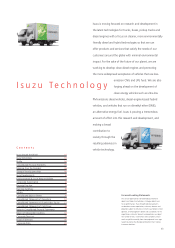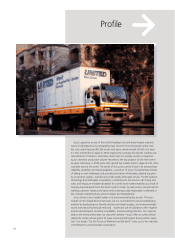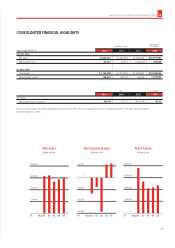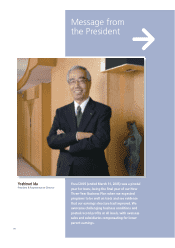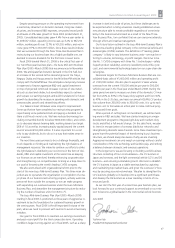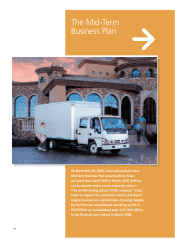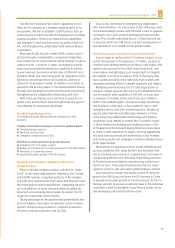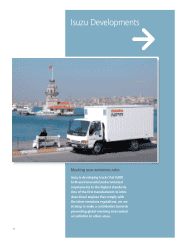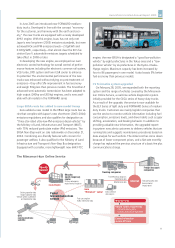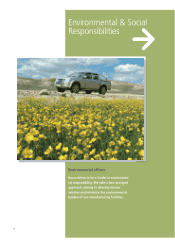Isuzu 2005 Annual Report Download - page 12
Download and view the complete annual report
Please find page 12 of the 2005 Isuzu annual report below. You can navigate through the pages in the report by either clicking on the pages listed below, or by using the keyword search tool below to find specific information within the annual report.
13
Contributing toward slowing global warming
Now that the Kyoto Protocol—an agreement among
developed countries that set targets for the reduction of
greenhouse gases—has taken effect, companies are re-
quired to dig deeper in their efforts to counteract global
warming. Two specific examples of Isuzu’s approach to
applying the brakes to global warming are participation in
the Japanese government-led Team Minus 6% Project and
developing products that help combat global warming.
The Isuzu Global Environmental Committee decided that
the company should join the Team Minus 6% Project, and
the Isuzu Team Minus 6% program kicked off on June 20,
2005.
Purpose of participation
As a CV/DE manufacturer, Isuzu’s mainstay business is to
provide fuel-efficient vehicles—vehicles with low CO
2
emis-
sions—worldwide. Our Mimamori-kun Online Service, built
around a vehicle diagnostic system that collects and ana-
lyzes data on driving habits to help truck drivers improve
their fuel economy—also contributes toward slowing global
warming.
We decided to take part in the Team Minus 6% Program
because we believe that, as good global citizens, Isuzu as a
company and Isuzu employees as individuals must do their
utmost to curtail CO
2
emissions in all aspects of daily activity
as well as through our mainstay business. We look forward
to seeing active participation from all employees in our ef-
forts to help create an environmentally sustainable society.
Isuzu’s team structure
We intend to develop specific action programs for the fol-
lowing committees: Plant Environment Committee, Product
Development Environment Committee, Sales and Service
Environment Committee, and General Affairs Committee.
All Isuzu group companies and sales companies will be tak-
ing part in the program—Isuzu group companies and all
their employees are members of the Isuzu Team.
Action plan
Isuzu decided on the following policies in line with guide-
lines set by the Japanese government:
1.
Set air conditioner thermostats at plants, headquarters
offices, and in homes at 28ºC. Employees are encouraged
to dispense with suit jackets and ties during the summer,
from June through September (Cool Biz dress code).
2.
Turn off water taps after use and fix leaks immediately.
3.
Minimize engine idling when driving delivery vehicles,
conveyance vehicles, and private cars.
4.
Use energy-saving appliances and eco-friendly household
goods.
5.
Avoid use of unnecessary packaging and take own shop-
ping bags to the store.
6.
Turn off power outlets and mains supplies when not in use.
«
Isuzu Motors Limited Annual Report 2005
The Team Isuzu’s target
Our target is to reduce CO
2
emissions by 6% from their
current level by 2010. This is an ambitious undertaking on
a consolidated basis and it assumes our current production
volume remains constant. We remain committed to taking
aggressive steps to help counteract global warming, such
as by introducing energy-efficient facilities.
Developing cleaner vehicles
In April 2005, Isuzu announced the addition of a new
model that runs on compressed natural gas (CNG) to its
lineup of ELF low-pollution, light-duty trucks. The ELF CNG-
MPI is the first CNG vehicle that meets the new long-term
exhaust emissions regulations and conforms to proposed
post new long-term exhaust emissions standards for diesel
engines. Equipped with a 4.6-liter new 4HV1 multi-point in-
jection (MPI) engine, the ELF CNG-MPI sets a new standard
for the low emissions levels typical of CNG vehicles. Power
and performance has also been upgraded with best-in-class
maximum output of 96kW (130PS) and maximum torque of
363N.m (37.0kg.m). Demand for vehicles that use natural
gas as fuel is growing among local governments and logis-
tics companies in major cities that suffer from severe air pol-
lution problems. Since its debut, sales of the ELF CNG range
has topped 7,000 units and maintained a dominant market
share of approximately 70%. The latest model combines the
low noise, low-vibration advantages of CNG vehicles with
excellent fuel economy.
Also in April 2005, Isuzu announced the addition of a new
diesel hybrid truck to the ELF range of low pollution, light-
duty trucks. The new ELF Hybrid, based on the 4HL1 diesel
engine, achieves low-CO
2
emission levels and high fuel effi-
ciency by fully recovering energy available when the vehicle
decelerates. A diesel vehicle that can be serviced anywhere,
the ELF Hybrid achieves world-class fuel economy compared
with other hybrid vehicles and delivers the high durability
and safety performance required of commercial vehicles.
It has been certified as an ultra-low PM emission diesel
vehicle and designated a “good low-pollution vehicle” by
eight prefectures in the Tokyo area. As well as the standard
Smoother-E automatic shift, the ELF Hybrid is equipped with
a secure PTO-type parallel drive hybrid system, with the mo-
tor and generator installed on a shaft different from that of
the engine. This ensures that in the event of a failure of the
hybrid system, the vehicle can continue to drive using the
diesel engine. Furthermore, it is the first Japanese truck to
use a lithium ion battery.
Isuzu positions the two new series—CNG-MPI vehicles
with excellent low-emissions performance and practical
diesel hybrid vehicles that require no specific fuel infrastruc-
ture— as the two mainstays of its low-pollution vehicle
lineup.


